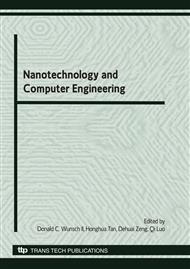[1]
D. D. Ren, M. Xue, and A. Henderson-Sellers, Incorporating hydraulic lift into a land surface model and its effects on surface soil moisture prediction, Journal of Hydrometeorology, vol. 5(2004), pp.1181-1191.
DOI: 10.1175/jhm-385.1
Google Scholar
[2]
J. D. Kalma and G. Boulet, Measurement and prediction of soil moisture in a medium-sized catchment, Hydrological Sciences Journal-Journal Des Sciences Hydrologiques, vol. 43(1998), pp.597-610.
DOI: 10.1080/02626669809492156
Google Scholar
[3]
Y. Shao, L. M. Leslie, R. K. Munro, P. Irannejad, W. F. Lyons, R. Morison, D. Short, and M. S. Wood, Soil moisture prediction over the Australian continent, Meteorology and Atmospheric Physics, vol. 63(1997), pp.195-215.
DOI: 10.1007/bf01027385
Google Scholar
[4]
Z. L. Hu and S. Islam, Prediction of Ground Surface-Temperature and Soil-Moisture Content by the Force-Restore Method, Water Resources Research, vol. 31(1995), pp.2531-2539.
DOI: 10.1029/95wr01650
Google Scholar
[5]
K. J. Beven and M. J. Kirkby, A physically based variable contributing area model of basin hydrology, Hydrological Science Bulletin, vol. 43(1979), pp.43-69.
DOI: 10.1080/02626667909491834
Google Scholar
[6]
R. J. Zhao, The Xinanjiang Model, in Hydrological Forecasting Proceedings Oxford Symposium, IASH, Oxford(1980), pp.351-356.
Google Scholar
[7]
R. J. Zhao, The Xinanjiang Model Applied in China, Journal of Hydrology, vol. 135(1992), pp.371-381.
Google Scholar
[8]
T. Y. Gan, E. M. Dlamini, and G. F. Biftu, Effects of model complexity and structure, data quality, and objective functions on hydrologic modeling, Journal of Hydrology, vol. 192(1997), pp.81-103.
DOI: 10.1016/s0022-1694(96)03114-9
Google Scholar
[9]
L. L. Ren, Q. Huang, F. Yuan, J. X. Wang, J. Xu, Z. B. Yu, and X. R. Liu, Evaluation of the Xinanjiang model structure by observed discharge and gauged soil moisture data in the HUBEX/GAME Project, Predictions in Ungauged Basins: Promise and Progress, vol. 303(2006).
Google Scholar
[10]
J. XU, J. ZHAO, W. ZHANG, Z. HU, and Z. Zheng, Mid-short-term daily runoff forecasting by anns and multiple process-based hydrological models., in Proc. - IEEE Youth Conf. Inf., Comput. Telecommun., YC-ICT, 2009, pp.526-529.
DOI: 10.1109/ycict.2009.5382440
Google Scholar
[11]
J. XU, X. ZHU, W. ZHANG, X. XU, and J. XIAN, Daily streamflow forecasting by artificial neural network in a large-scale basin, in Proc. - IEEE Youth Conf. Inf., Comput. Telecommun., YC-ICT, 2009, pp.487-490.
DOI: 10.1109/ycict.2009.5382453
Google Scholar
[12]
P. Srivastava, J. N. McVair, and T. E. Johnson, Comparison of process-based and artificial neural network approaches for streamflow modeling in an agricultural watershed, Journal of the American Water Resources Association, vol. 42(2006).
DOI: 10.1111/j.1752-1688.2006.tb04475.x
Google Scholar
[13]
M. C. Demirel, A. Venancio, and E. Kahya, Flow forecast by SWAT model and ANN in Pracana basin, Portugal, Advances in Engineering Software, vol. 40(2006), pp.467-473.
DOI: 10.1016/j.advengsoft.2008.08.002
Google Scholar
[14]
L. Zhi-jia, Y. Cheng, and K. Xiang-guang, THE IMPROVED XINANJIANG MODEL, Journal of Hydrodynamics,Ser.B, vol. 17(2005), pp.746-751.
Google Scholar


